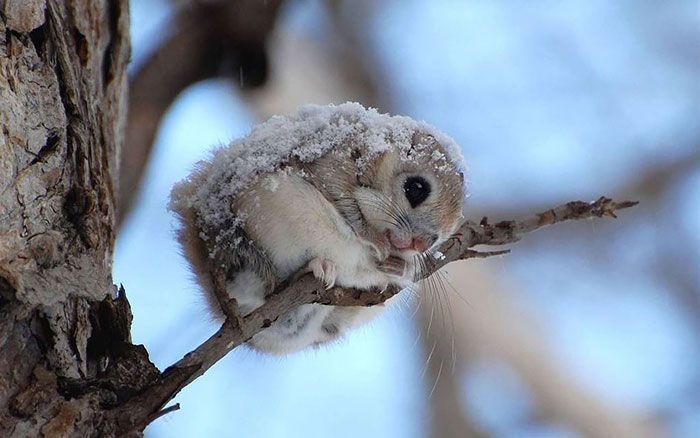|
|
Flying Squirrel
|
Flying squirrels are not capable of flight like birds or bats; instead, they glide between trees. They are capable of obtaining lift within the course of these flights, with flights recorded to 90 meters (295 ft). The direction and speed of the animal in midair are varied by changing the positions of its limbs, largely controlled by small cartilaginous wrist bones. The wrist is connected to the styliform cartilage, which forms a wing tip used during gliding. After being extended, the wing tip may adjust to various angles, controlling aerodynamic movements. The wrist also changes the tautness of the patagium, a furry parachute-like membrane that stretches from wrist to ankle. It has a fluffy tail that stabilizes in flight. The tail acts as an adjunct airfoil, working as an air brake before landing on a tree trunk.
The colugos, Petauridae, and Anomaluridae are gliding mammals which are similar to flying squirrels because of convergent evolution. These mammals can glide through the trees, but they do not actually fly (like birds and bats). They have a membrane of skin on either side of their body.
Prior to the 21st century, the evolutionary history of the flying squirrel was frequently debated. This debate was clarified greatly as a result of two molecular studies. These studies found support that flying squirrels originated 18–20 million years ago, are monophyletic, and have a sister relationship with tree squirrels. Due to their close ancestry, the morphological differences between flying squirrels and tree squirrels reveal insight into the formation of the gliding mechanism. By comparing northern and southern flying squirrels to tree squirrels of similar size, flying squirrels show lengthening in bones, such as those of the lumbar vertebrae and forearm, while the feet, hands, and distal vertebrae are reduced in length relative to the tree squirrels. Such differences in body proportions reveal the flying squirrels’ adaptation to minimize wing loading and allow for more maneuverability while gliding.
There are multiple hypotheses that attempt to explain the evolution of the gliding mechanism in flying squirrels. One possible explanation is related to energy efficiency and foraging. Gliding is an energetically efficient way to progress from one tree to another while foraging, as opposed to climbing down trees and maneuvering on the ground floor or executing dangerous leaps in the air. Flying squirrels are also able to rummage through a greater area of forest more quickly than tree squirrels due to gliding at high speeds. They are adapted to gliding long distances by increasing their aerial speed and producing more lift. Other hypotheses state that the mechanism evolved to avoid nearby predators and prevent injuries. If a dangerous situation arises on a specific tree, flying squirrels have the ability to glide to another, typically assuring safety from the previous danger. Furthermore, take-off and landing procedures during leaps, implemented for safety purposes, may explain the gliding mechanism. While leaps at high speeds are important to escape danger, the high-force impact of landing on a new tree could be detrimental to a squirrel’s health. Yet the gliding mechanism of flying squirrels involves structures and techniques during flight that allow for great stability and control. If a leap is miscalculated, a flying squirrel may easily steer back onto the original course by using its gliding ability. A flying squirrel also creates a large glide angle when approaching its target tree, decreasing its velocity due to an increase in air resistance and allowing all four limbs to absorb the impact of the target.
|
|









